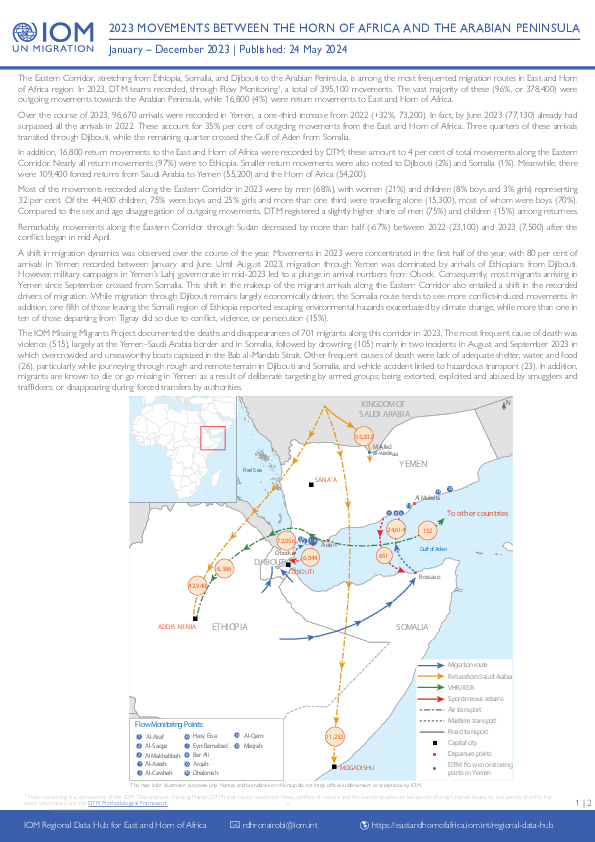-
Countries
-
Data and Analysis
-
Special Focus
-
Crisis Responses
Flow Monitoring
Domain host
migration.iom.int

Contact
DTM Mauritania, DTMMauritania@iom.int
Language
French
Location
Mauritania
Period Covered
Feb 11 2024
May 07 2024
Activity
- Survey
- Flow Monitoring Survey
- Flow Monitoring
La transhumance est une tradition par laquelle des éleveurs se déplacent à la recherche d’eau et de pâturages. En Mauritanie, pays désertique, elle constitue un moyen d’adaptation pour les transhumants afin de palier au déficit de ressources pastorales. De ce fait des mouvements de transhumance sont observés principalement de la Mauritanie vers le Mali. Cependant, des mouvements inverses sont également notés, motivés principalement par la recherche de cure salée en Mauritanie par les transhumants Maliens ou Sénégalais. Ainsi, le calendrier et les itinéraires de transhumances se font en concordance des pluies, ainsi que de la distribution de l’eau et des pâturages, qui varient d’une saison à l’autre. Compte tenu des conditions environnementales difficiles en Mauritanie et des répercussions sur les productions végétales et animales, y compris sur la sécurité alimentaire des populations, et dans le contexte actuel d’aléas climatiques, économiques et sécuritaires croissants, on constate que les systèmes de mobilité pastorale connaissent des évolutions importantes sous les effets combinés du changement climatique, de la pression démographique, de la baisse de la fertilité des sols et de l’insécurité.
Dans le cadre du projet « Soutenir les capacités locales et communautaires de prévention et de gestion des conflits et des catastrophes liées au changement climatique au Guidimaghaa » financé par le Peace Building Fund (PBF) et mis en œuvre par l’Organisation internationale pour les migrations (OIM), au niveau de la Wilaya du Guidimaghaa, plusieurs activités sont mises en place y compris des activités de collecte de données sur la migration et le changement climatique.
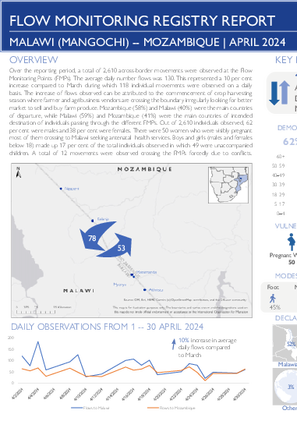
Contact
ROPretoriaRMDHub@iom.int
Language
English
Location
Malawi
Period Covered
Apr 01 2024
Apr 30 2024
Activity
- Flow Monitoring
This report is an overview of the data collected from 1 to 30 April 2024 at Mangochi FMP in Malawi along the border with Mozambique and Karonga FMP in Malawi along the border with the United Republic of Tanzania. The Flow Monitoring Registry (FMR) collects data at Flow Monitoring Points (FMPs) through direct observation and interviews with key informants, including staff working at transit stations, border patrol officers, local authorities, bus or taxi drivers and travellers themselves. The FMR gathers data on the number of travellers crossing FMPs, as well as the provenance, next destination, vulnerabilities and means of transport of travellers.
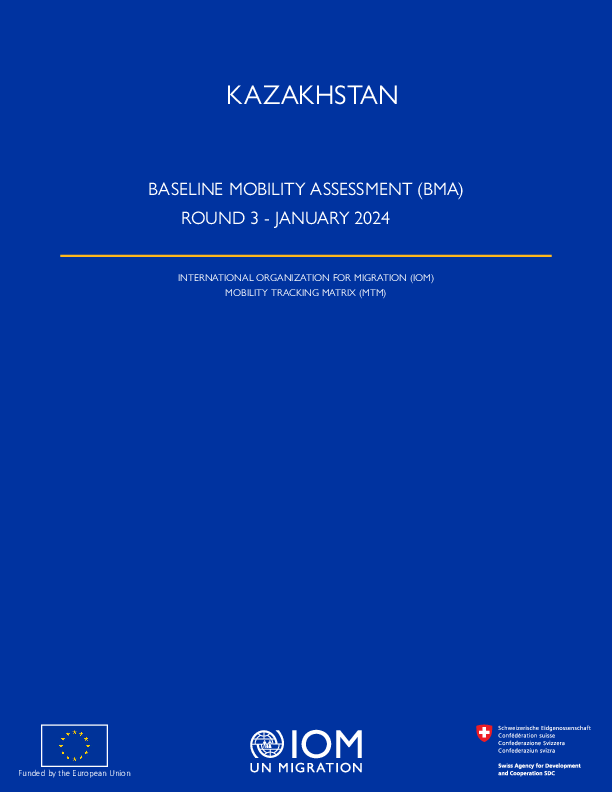
Contact
iomastana@iom.int iomalmaty@iom.int
Language
English
Location
Kazakhstan
Period Covered
Jan 01 2024
Jan 31 2024
Activity
- Survey
- Return Intention
- Mobility Tracking
- Baseline Assessment
The Mobility Tracking Matrix (MTM) is a system that tracks and monitors population mobility and displacement. MTM is adapted to the context in Kazakhstan based on IOM’s Global Displacement Tracking Matrix (DTM) methodology. DTM is designed to regularly and systematically capture, process, and disseminate information to provide a better understanding of the movements and evolving needs of mobile population groups, whether on-site or en route. MTM completed its first round of the Baseline Mobility Assessment (BMA) data collection on the district level in January 2023, the second round of BMA on the district level in May 2023, and the third round on the village level in December 2023. MTM enables IOM and its partners to maximize resources, set priorities, and deliver better-targeted, evidence-based, mobility-sensitive, and sustainable humanitarian and development programming.
This report provides insights into the profiles, experiences, needs, routes travelled and intentions of migrants transiting through the Western Balkans.
IOM surveyed 1,033 migrants from 1 April to 30 April 2024 in Albania, Bosnia and Herzegovina, Montenegro, North Macedonia, Serbia and Kosovo*.
* References to Kosovo* shall be understood in the context of UN Security Council Resolution 1244 (1999).
Over the course of 2023, 96,670 arrivals were recorded in Yemen, a one-third increase from 2022 (+32%, 73,200). In fact, by June 2023 (77,130) already had surpassed all the arrivals in 2022. These account for 35% per cent of outgoing movements from the East and Horn of Africa. Three quarters of these arrivals transited through Djibouti, while the remaining quarter crossed the Gulf of Aden from Somalia
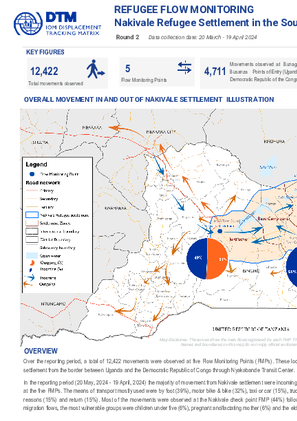
Contact
dtmuganda@iom.int
Language
English
Location
Uganda
Period Covered
Mar 20 2024
Apr 19 2024
Activity
- Flow Monitoring
Over the reporting period, a total of 12,422 movements were observed at five Flow Monitoring Points (FMPs). These locations were chosen strategically as major transit points for monitoring movements in and out of Nakivale settlement from the border between Uganda and the Democratic Republic of Congo through Nyakabande Transit Center.
In the reporting period (20 May, 2024 - 19 April, 2024) the majority of movement from Nakivale settlement were incoming flows (52%) against outgoing flows (48%). Forty-four per cent of the observed movements were refugees at the five FMPs. The means of transport mostly used were by foot (39%), motor bike & bike (32%), taxi or car (15%), truck (8%), bus (3%) and others (2%). The majority of the flows were due to economic reasons (26%), family reasons (15%) and return (15%). Most of the movements were observed at the Nakivale check point FMP (44%) followed by Busanza (19%), Bunagana (19%), Rugaaga (11%) and Nyakabande transit centre (7%). Among migration flows, the most vulnerable groups were children under five (6%), pregnant and/lactating mother (6%) and the elderly (<1%).
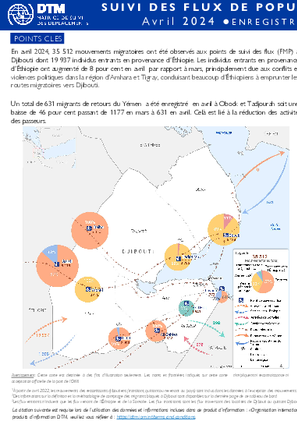
Contact
DTM Djibouti, DTMDjibouti@iom.int
Language
English
Location
Djibouti
Period Covered
Apr 01 2024
Apr 01 2024
Activity
- Flow Monitoring
En avril 2024, 35 512 mouvements migratoires ont été observés aux points de suivi des flux (FMP) à Djibouti dont 19 937 individus entrants en provenance d’Éthiopie. Les individus entrants en provenance d’Éthiopie ont augmenté de 8 pour cent en avril par rapport à mars, principalement due aux conflits et violences politiques dans la région d’Amhara et Tigray, conduisant beaucoup d’Éthiopiens à emprunter les routes migratoires vers Djibouti.
Un total de 631 migrants de retours du Yémen a été enregistré en avril à Obock et Tadjourah soit une baisse de 46 pour cent passant de 1177 en mars à 631 en avril. Celà est lié à la réduction des activités des passeurs.

Contact
DTM Djibouti, DTMDjibouti@iom.int
Language
English
Location
Djibouti
Period Covered
Apr 01 2024
Apr 30 2024
Activity
- Flow Monitoring
In April 2024, 35,512 migratory movements were observed at Djibouti's Flow Monitoring Points (FMPs), including 19,937 incoming individuals from Ethiopia. Inbound individuals from Ethiopia increased by 8 per cent in April compared to March, mainly due to the conflicts and political violence in the Amhara and Tigray region, leading many Ethiopians to take the migration routes to Djibouti.
A total of 631 return migrants from Yemen were recorded in April in Obock and Tadjourah, down 46 per cent from 1,177 in March. This is linked to the reduction in the activities of smugglers.
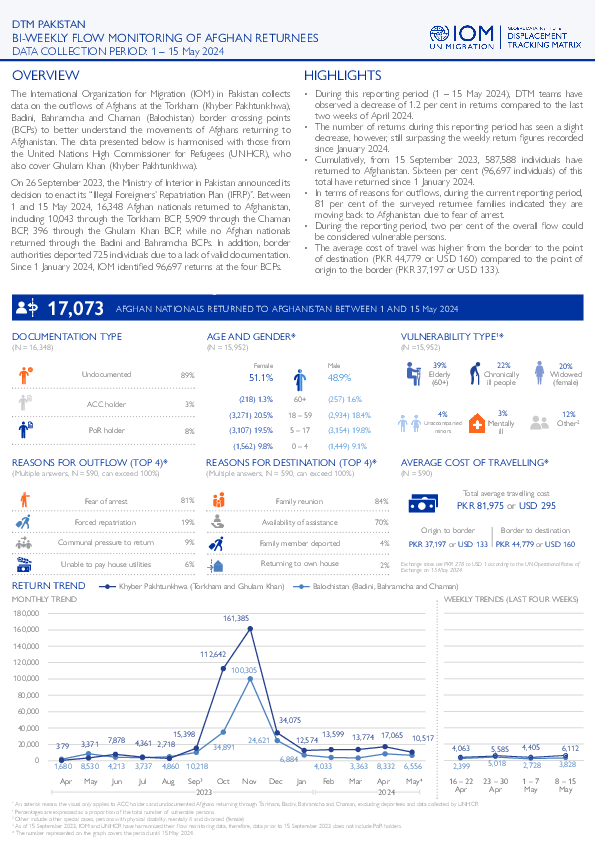
Contact
DTM Pakistan, dtmpakistan@iom.int
Language
English
Location
Pakistan
Period Covered
May 01 2024
May 15 2024
Activity
- Flow Monitoring
The International Organization for Migration (IOM) in Pakistan collects data on the outflows of Afghans at the Torkham (Khyber Pakhtunkhwa), Badini, Bahramcha and Chaman (Balochistan) border crossing points (BCPs) to better understand the movements of Afghans returning to Afghanistan. The data presented below is harmonised with those from the United Nations High Commissioner for Refugees (UNHCR), who also cover Ghulam Khan (Khyber Pakhtunkhwa).
On 26 September 2023, the Ministry of Interior in Pakistan announced its decision to enact its “Illegal Foreigners’ Repatriation Plan (IFRP)”. Between 1 and 15 May 2024, 16,348 Afghan nationals returned to Afghanistan, including 10,043 through the Torkham BCP, 5,909 through the Chaman BCP, 396 through the Ghulam Khan BCP, while no Afghan nationals returned through the Badini and Bahramcha BCPs. In addition, border authorities deported 725 individuals due to a lack of valid documentation. Since 1 January 2024, IOM identified 96,697 returns at the four BCPs.
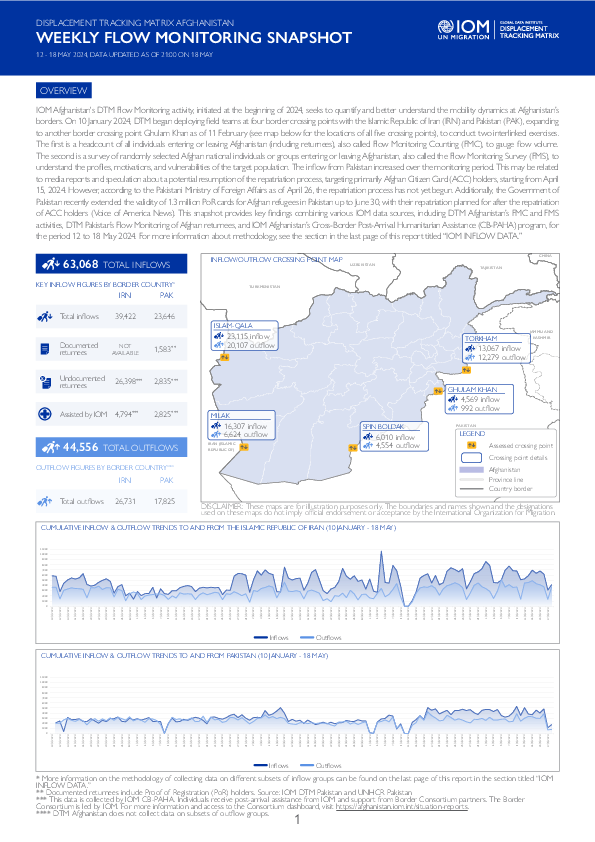
Contact
DTMAfghanistan@iom.int
Language
English
Location
Afghanistan
Period Covered
May 12 2024
May 18 2024
Activity
- Survey
- Flow Monitoring Survey
- Flow Monitoring
IOM Afghanistan's DTM Flow Monitoring activity, initiated at the beginning of 2024, seeks to quantify and better understand the mobility dynamics at Afghanistan’s borders. On 10 January 2024, DTM began deploying field teams at four border crossing points with the Islamic Republic of Iran (IRN) and Pakistan (PAK), expanding to another border crossing point Ghulam Khan as of 11 February (see map below for the locations of all five crossing points), to conduct two interlinked exercises. The first is a headcount of all individuals entering or leaving Afghanistan (including returnees), also called Flow Monitoring Counting (FMC), to gauge flow volume. The second is a survey of randomly selected Afghan national individuals or groups entering or leaving Afghanistan, also called the Flow Monitoring Survey (FMS), to understand the profiles, motivations, and vulnerabilities of the target population. The inflow from Pakistan increased over the monitoring period. This may be related to media reports and speculation about a potential resumption of the repatriation process, targeting primarily Afghan Citizen Card (ACC) holders, starting from April 15, 2024. However, according to the Pakistani Ministry of Foreign Affairs as of April 26, the repatriation process has not yet begun. Additionally, the Government of Pakistan recently extended the validity of 1.3 million PoR cards for Afghan refugees in Pakistan up to June 30, with their repatriation planned for after the repatriation of ACC holders (Voice of America News). This snapshot provides key findings combining various IOM data sources, including DTM Afghanistan’s FMC and FMS activities, DTM Pakistan’s Flow Monitoring of Afghan returnees, and IOM Afghanistan’s Cross-Border Post-Arrival Humanitarian Assistance (CB-PAHA) program, for the period 12 to 18 May 2024. For more information about methodology, see the section in the last page of this report titled “IOM INFLOW DATA.”
Pagination
- Previous page
- Page 8
- Next page

